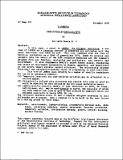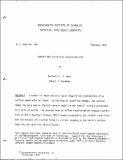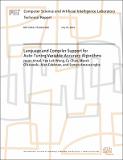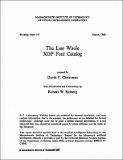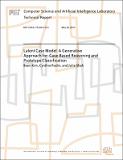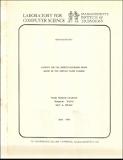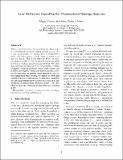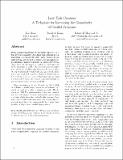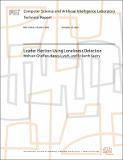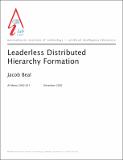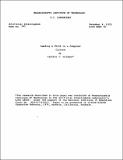Browsing Computer Science and Artificial Intelligence Lab (CSAIL) by Title
Now showing items 1776-1795 of 3804
-
Lambda Calculus Models of Programming Languages
(1968-12)Two aspects of programming languages, recursive definitions and type declarations are analyzed in detail. Church's -calculus is used as a model of a programming language for purposes of the analysis. The main result on ... -
LAMBDA: The Ultimate Declarative
(1976-11-01)In this paper, a sequel to "LAMBDA: The U ltimate Imperative", a new view of LAMBDA as a renaming operator is presented and contrasted with the usual functional view taken by L ISP. This view, combined with the view of ... -
Lambda: The Ultimate Imperative
(1976-03-01)We demonstrate how to model the following common programmingsconstructs in terms of an applicative order language similar to LISP: Simple Recursion, Iteration, Compound Statements and Expressions, GO TO and Assignment, ... -
LANDSAT MSS Coordinate Transformations
(1978-02-01)A number of image analysis tasks require the registration of a surface model with an image. In the case of satellite images, the surface model may be a map or digital terrain model in the form of surface elevations on ... -
Language and Compiler Support for Auto-Tuning Variable-Accuracy Algorithms
(2010-07-27)Approximating ideal program outputs is a common technique for solving computationally difficult problems, for adhering to processing or timing constraints, and for performance optimization in situations where perfect ... -
The Last Whole XGP Font Catalog
(MIT Artificial Intelligence Laboratory, 1980-03) -
Latent Case Model: A Generative Approach for Case-Based Reasoning and Prototype Classification
(2014-05-26)We present a general framework for Bayesian case-based reasoning and prototype classification and clustering -- Latent Case Model (LCM). LCM learns the most representative prototype observations of a dataset by performing ... -
Latent-Dynamic Discriminative Models for Continuous Gesture Recognition
(2007-01-07)Many problems in vision involve the prediction of a class label for each frame in an unsegmented sequence. In this paper we develop a discriminative framework for simultaneous sequence segmentation and labeling which can ... -
A Lattice-structured Proof Technique Applied to a Minimum Spanning Tree Algorithm
(1988-06)Higly-optimized concurrent algorithms are often hard to prove correct because they have no natural decomposition into separately provable parts. This paper presents a proof technique for the modular verification of such ... -
Laws for Communicating Parallel Processes
(MIT Artificial Intelligence Laboratory, 1976-11)This paper presents some "laws" that must be satisfied by computations involving communicating parallel processes. The laws take the form of stating restrictions on the histories of computations that are physically realizable. ... -
Laws for Communicating Parallel Processes
(MIT Artificial Intelligence Laboratory, 1977-05-10)This paper presents some laws that must be satisfied by computations involving communicating parallel processes. The laws are stated in the context of the actor theory, a model for distributed parallel computation, and ... -
A Layered Virtual Memory Manager
(1977-05)This thesis presents a specification for the Multics virtual memory manager. The virtual memory manager is that part of the operating system which coordinates the usage of physical memory and which manages the bindings ... -
Layouts for the Shuffle-exchange Graph and Lower Bound Techniques for VLSI
(1982-08)The thesis is divided into two parts. In the first part, we describe and analyze several new VLSI layouts for the shuffle-exchange graph. These include:1) an asymptotically optimal, (N /log N)-area layout for the ... -
Layouts for the Suffle-Exchange Graph Based on the Complex Plane Diagram
(1982-06)The shuffule-exchange graph is one of the best structures known for parallel computation. Among other things, a shuffle-exchange computer can be used to compute discrete. Fourier transforms, multiply matrices, evaluate ... -
Lazy Reference Counting for Transactional Storage Systems
(1997-10)HAC is a novel technique for managing the direct the client cache in a distributed, persistent object storage system. In a companion paper, we showed that it outperforms other techniques across a wide range of cache sizes ... -
Lazy Replication: Exploiting the Semantics of Distributed Services
(1990-07)To provide high availability for services such as mail or bulletin boards, data must be replicated. One way to guarantee consistency of replicated data is to force service operations to occur in the same order at all ... -
Lazy Task Creation: A Technique for Increasing the Granularity of Parallel Programs
(1991-06)Many parallel algorithms are naturally expressed at a fine level of granularity, often finer than MIMD parallel system can exploit efficiently. Most builders of parallel systems have looked to either the programmer or a ... -
Leader Election Using Loneliness Detection
(2011-10-12)We consider the problem of leader election (LE) in single-hop radio networks with synchronized time slots for transmitting and receiving messages. We assume that the actual number n of processes is unknown, while the size ... -
Leaderless Distributed Hierarchy Formation
(2002-12-01)I present a system for robust leaderless organization of an amorphous network into hierarchical clusters. This system, which assumes that nodes are spatially embedded and can only talk to neighbors within a given radius, ... -
Leading a Child to a Computer Culture
(1975-12-01)"LOGO" is sometimes used as the name of a programming language. It is also used as the name of...what shall I call it?... an environment, a culture, a way of thinking about computers and about learning and about putting ...


